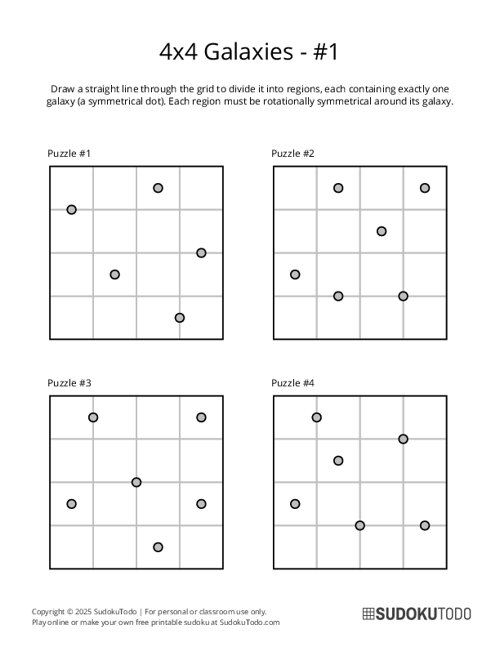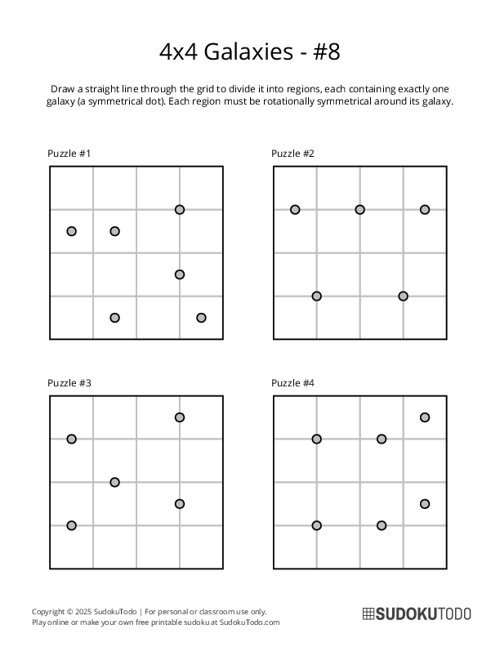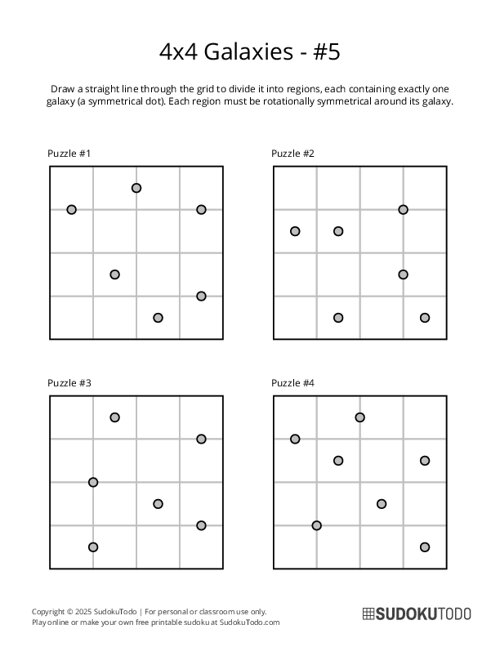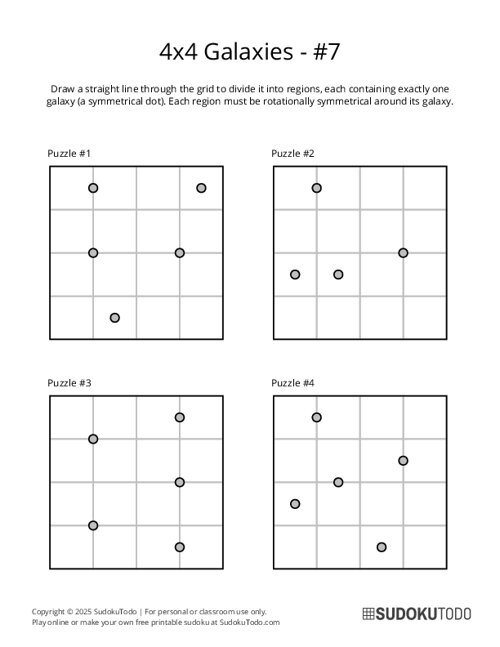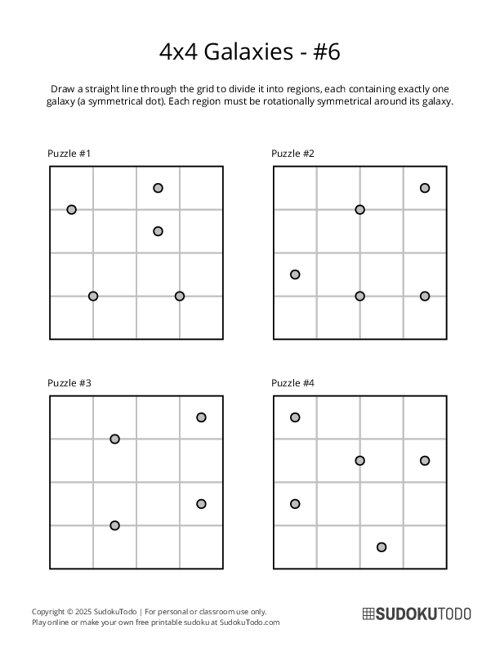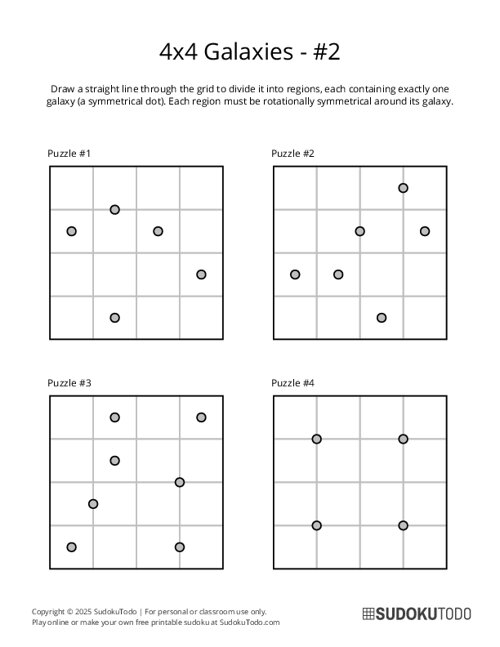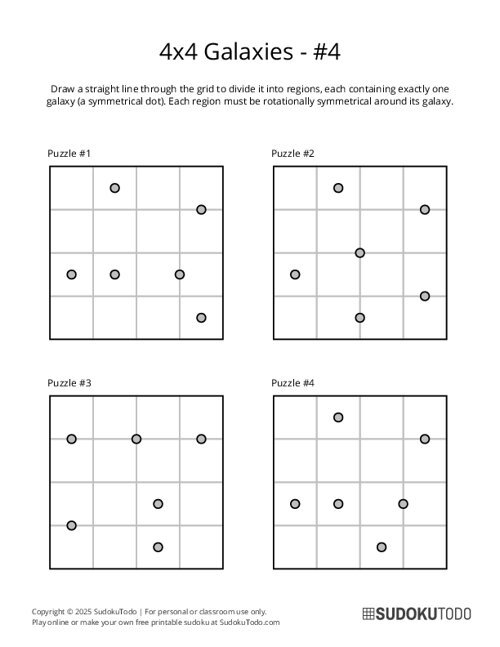Printable Sudoku
- Alphabet
- Battleships
- Binary
- Bridges / Hashi
- Chain Sudoku
- Consecutive
- Cross Sudoku
- Flower Sudoku
- Frame Sudoku
- Futoshiki
- Galaxies
- Greater Than
- Hitori
- Jigsaw Sudoku
- Kakuro
- KenKen
- Killer Sudoku
- Kropki Sudoku
- Little Killer
- Magic Squares
- Nonogram
- Odd Even Sudoku
- Outside Sudoku
- Rossini Sudoku
- Samurai Sudoku
- Sandwich
- Skyscraper
- Slitherlink
- Sohei Sudoku
- Star Battle
- Sudoku
- Sudoku for Kids
- Sudoku Mine
- Sudoku XV
- Sujiken
- Tripledoku
- Tripod Sudoku
- Twodoku
- Vudoku
- Windmill
Special Variations
Play / Solve
4x4 Galaxy Puzzles
Explore our free printable 4x4 Galaxies / Tentai Show logic puzzles. These fun and printable challenges are great for all skill levels. Use your logic and spatial skills to divide the grid into symmetrical shapes around galaxy centers. Download now and enjoy hours of brain-teasing fun.
- 4 x 4
Showing 1-10 of 10 records
Sort by:
You are browsing category 4 x 4 show all
4x4 Galaxies - 1
4x4 Galaxies - 3
4x4 Galaxies - 8
4x4 Galaxies - 5
4x4 Galaxies - 9
4x4 Galaxies - 7
4x4 Galaxies - 10
4x4 Galaxies - 6
4x4 Galaxies - 2
4x4 Galaxies - 4
About Galaxies Puzzle
Galaxies (also known as Tentai Show or Symmetry) is a logic puzzle played on a rectangular grid. The puzzle consists of dots placed in specific locations across the grid, each representing the center of a symmetric region (or "galaxy"). The objective is to divide the grid into symmetrical regions, with each region containing exactly one dot at its center.
Basic Rules / How to Play
- Grid Division: The grid must be divided into regions (galaxies) such that every cell belongs to exactly one galaxy.
- Central Circle: Each galaxy must contain exactly one circled cell, which serves as the center of symmetry.
- Symmetry: Each region must be 180-degree rotationally symmetric around its dot. This means that if you rotate the region 180 degrees around its dot, it should look identical.
- Regions: Regions must be contiguous (all cells of a region must be connected).
- No Overlapping: Galaxies cannot overlap or extend beyond the grid. Every cell in the grid must belong to exactly one region.
Solving Tips and Techniques:
To successfully solve a Galaxies puzzle, consider the following techniques:
- Identify Fixed Cells: Some cells definitely belong to certain galaxies because of where they are compared to the dots. Cells next to a dot are usually part of that dot’s galaxy since they need to be balanced with other nearby cells.
- Use Rotational Symmetry: Each galaxy looks the same if you rotate it 180 degrees. So, if you find one part of a galaxy, you can easily find the matching part on the other side. If a galaxy has a cell at (x, y), then there must also be a matching cell at (x', y') in the same galaxy.
- Find Boundaries: Look for natural barriers like walls, grid edges, and already filled areas. If a dot is near a wall, the galaxy must grow evenly in all directions. This means it might not be able to expand as much in some directions.
- Extend Galaxies Step by Step: Expand each region evenly from its starting dot, making sure it keeps its shape and does not touch other galaxies. If a part of the region would overlap with another galaxy, change its shape to fit.
- Look for Even-Sized Expansions: Since the regions need to be the same on both sides, if you add a cell to one side, you must also add a matching cell to the other side. If something blocks one side (like a wall), you should expand in a way that keeps both sides balanced.
- Check for Dead Ends: If expanding an area causes problems, like breaking balance or making it impossible to solve, go back and change what you did before to fix it.
- Work with Multiple Galaxies at Once: Sometimes, solving one galaxy can help us understand the galaxies around it. If one area is clearly defined, the nearby galaxies will fill the remaining space while keeping everything balanced and in order.
Galaxy puzzles need you to think carefully about shapes and patterns. With practice, you'll get better at finding the edges of the galaxies and finishing the puzzle in a smart way.
